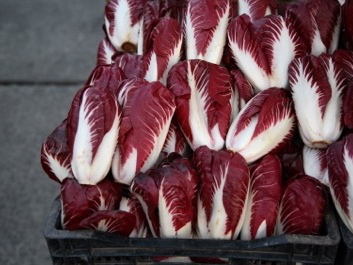
salad, l
(article, Helen Rennie)
[%pageBreakSettings nobreak=true] p(blue). Editor's note: Helen Rennie wrote the Front Burner column from January to June 2007. “Drop those tongs!” cried the chef, as if I were holding a dangerous weapon. It was my first day working the line during my restaurant internship, and I had already managed to mess up. I’d poured a few tablespoons of salad dressing into a bowl of mixed greens and started stirring the salad with tongs. I didn’t realize I was committing a crime against all salad-eating humanity. The chef took the bowl from my hands, dumped the ruined salad, and declared, “Watch!” She piled a bunch of greens into the bowl, sprinkled them with a generous pinch of salt, and poured in a scant drizzle of vinaigrette. “Less dressing, more salt,” she said. Then she reached in with her hand and gently tossed the salad greens as if they were feathers. [%image salad float=left width=300 credit="Photo courtesy Helen Rennie" caption="Salad deserves the best."] When she was done, the greens had just a bare shimmer of dressing evenly distributed on every leaf. “Always taste,” she instructed, popping a leaf into my mouth. It was livelier and more flavorful than any salad I’d ever made at home. Since then, the tongs have never touched my salad. Here are some tips for tossing together a better salad. h3. The greens You can make a great salad with all kinds of lettuce — from sturdy romaine to baby mixed greens — as long as the greens are fresh. Remove any wilted greens before making your salad, and make sure the greens are washed and dried well. Water is the enemy of salad, as it will keep the dressing from coating the greens properly. In the summer, the greens I get from local farms are worth the effort of washing and spinning. In winter, prewashed mixed greens, arugula, or spinach are perfect for an easy salad. h3. The salt Salad needs salt. Growing up on oversalted bottled salad dressing, generously poured over our greens, made us forget this fact. Adding salt to the salad itself, rather than to the dressing, allows you to dress your greens very lightly and still end up with the right balance of flavors. Unfortunately, table salt will not do; the iodine added to table salt leaves an unpleasant chemical aftertaste on raw foods. Kosher salt is my first choice for all foods, but sea salt works well, too. Just make sure it’s finely ground; sea salt is often sold in coarse form and requires a salt grinder. h3. The dressing Once you make your own dressing and realize how simple it is, you’ll hardly ever want to go back to the bottle. Vinaigrette is the simplest and most versatile dressing to have in your repertoire. Make it by whisking three parts olive oil into one part acid; my favorite acid is lemon or lime juice, but a white- or red-wine vinegar works great, too. Don’t worry if the dressing separates. All homemade vinaigrettes do; they simply need to be vigorously stirred before using. I like to add a little Dijon mustard to my acid before whisking in the oil, as it gives the dressing more complexity and helps it emulsify. [%image radicchio float=right width=400 credit="Photo: iStockphoto/dystortia" caption="Fresh radicchio makes a crisp winter salad."] Making your dressing in a little glass measuring cup allows you to easily measure ingredients, and the little spout is handy for pouring the dressing over a salad. Once you’ve mastered the basic technique, try adding variations: minced shallots, orange zest, maple syrup, honey, or grainy mustard. A splash of balsamic vinegar is always lovely, but I prefer not to use it as the main acidic ingredient since it makes for a rather heavy dressing. For a Caesar dressing, try adding mashed garlic and anchovies to your basic vinaigrette mixture. For an Asian vinaigrette, try a base of rice-wine vinegar and canola oil with splashes of soy sauce, fish sauce, and sesame-seed oil for flavor. A little grated ginger would not be out of place either. When making dressings with chunky ingredients that I want completely mashed — such as garlic, ginger, anchovies, and herbs — I prefer to use a blender to cut down on the prep work. An immersion blender is even better at puréeing small quantities than a regular one. Since you need very little to dress a salad, you’ll probably have leftover dressing. Your homemade dressing will sit in the fridge quite happily for at least a week. Don’t worry if it starts to solidify; olive oil tends to do that when it’s been refrigerated for several days. Just leave your dressing out at room temperature for 15 or 20 minutes before using. h3. The mixing technique Always dress your salads right before serving them, since the dressing (even in small amounts) will wilt the greens in less than 20 minutes. Put your salad in a bowl and add a splash of dressing (go easy on the dressing at first, since you can always add more) and a generous pinch of salt. Toss the leaves gently but thoroughly with your fingers, and taste a leaf. It should be flavorful and tangy, but still taste like itself, not like the dressing. If it’s not tangy enough, you need more dressing. If it’s not flavorful enough, you need more salt. Pile the salad on plates with your hands. You’ll be amazed how much taller and airier it looks than the bruised leaves handled by utensils. Bon appétit! p(bio). Culinate columnist Helen Rennie is a food writer (check out her blog) and cooking teacher living in Boston.

salad, l

radicchio, l

reference-image, l